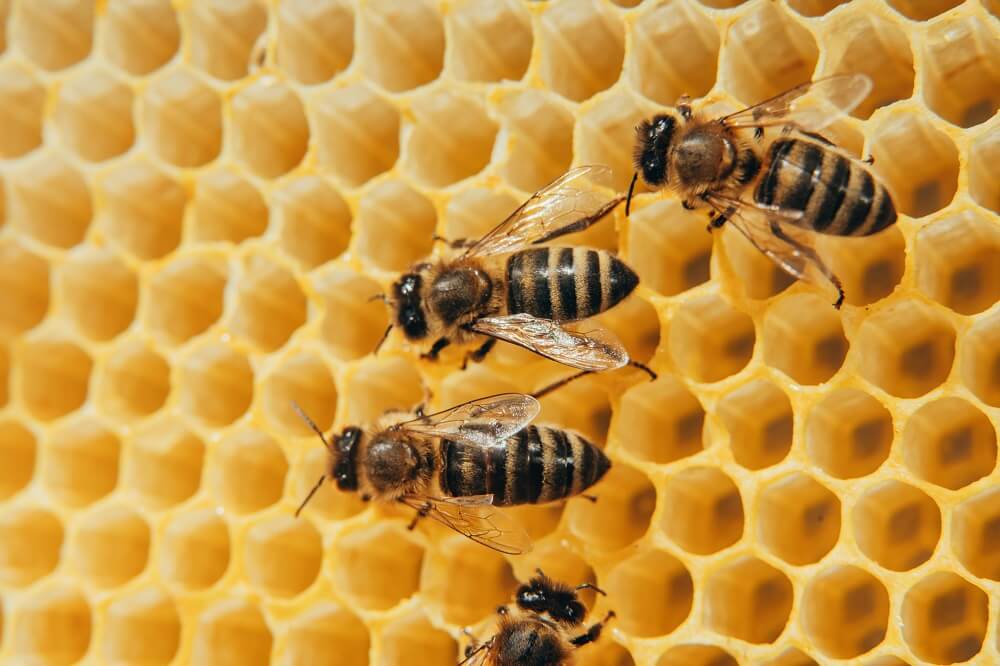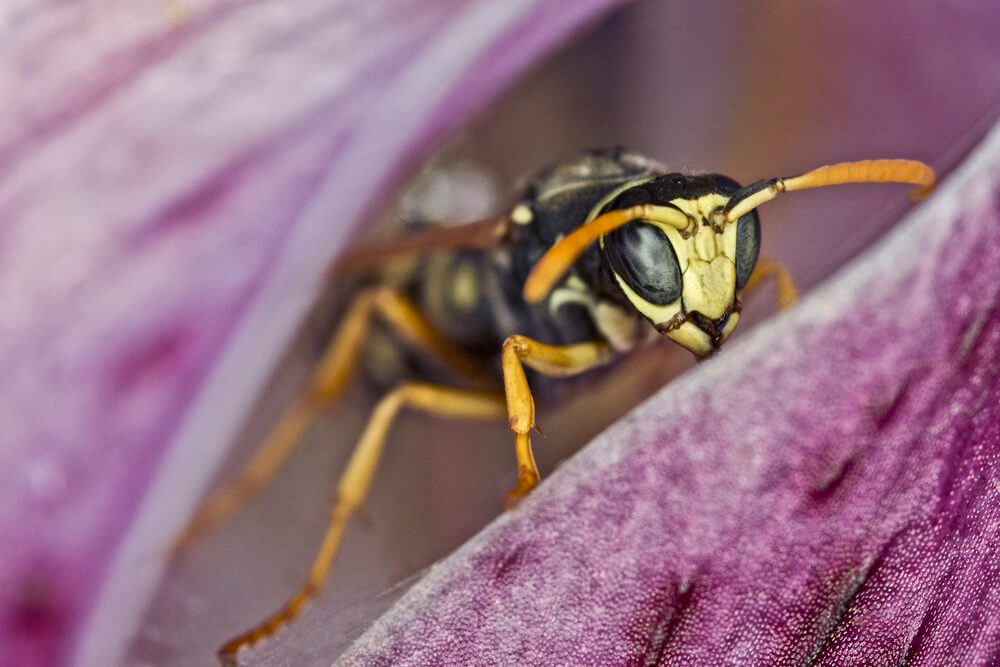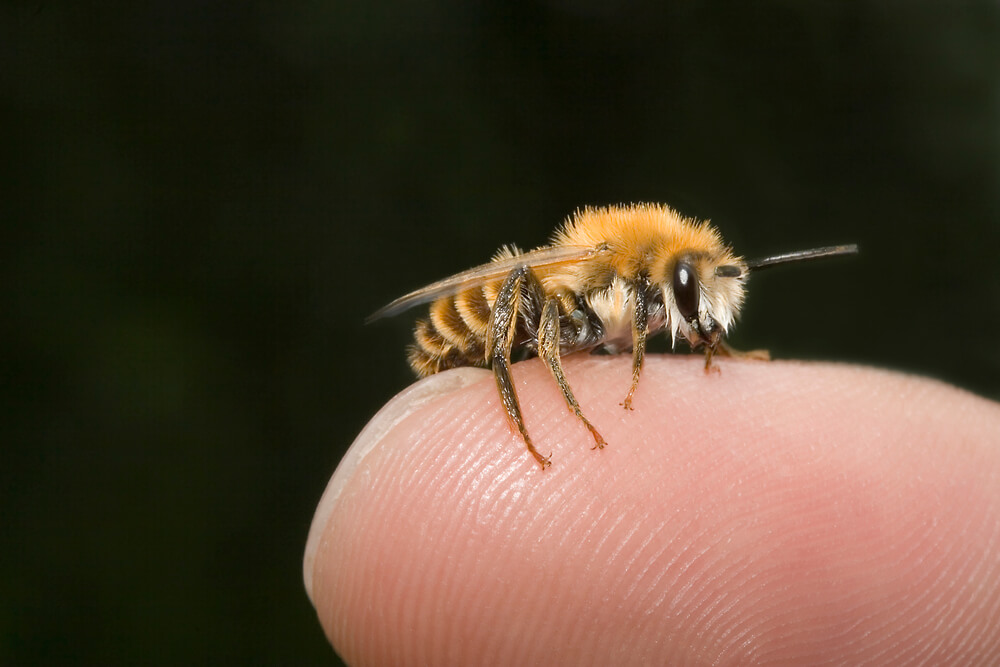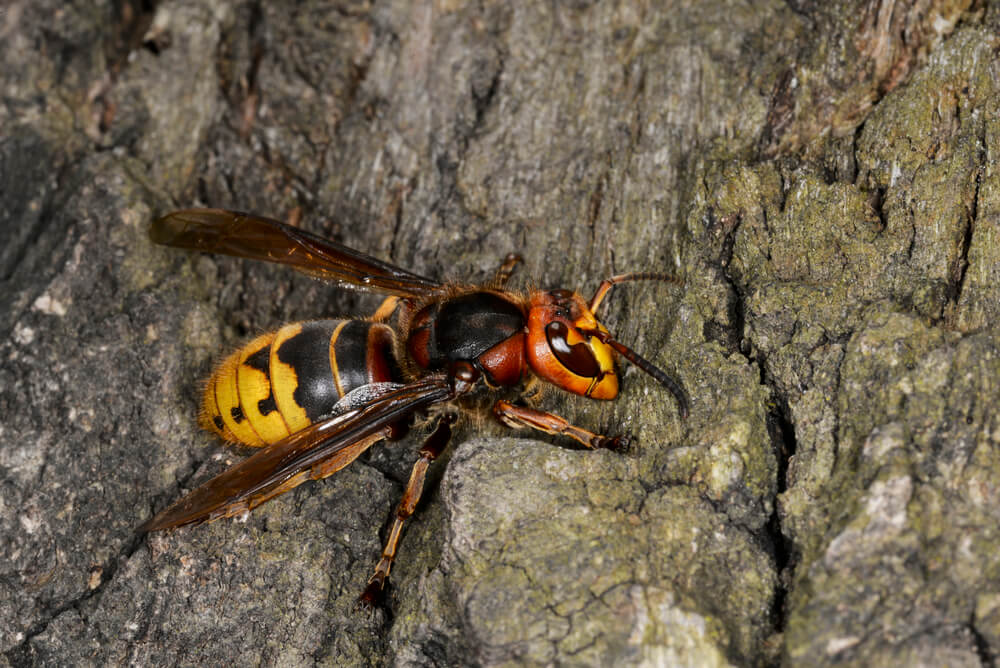How Do Bees Make Wax?
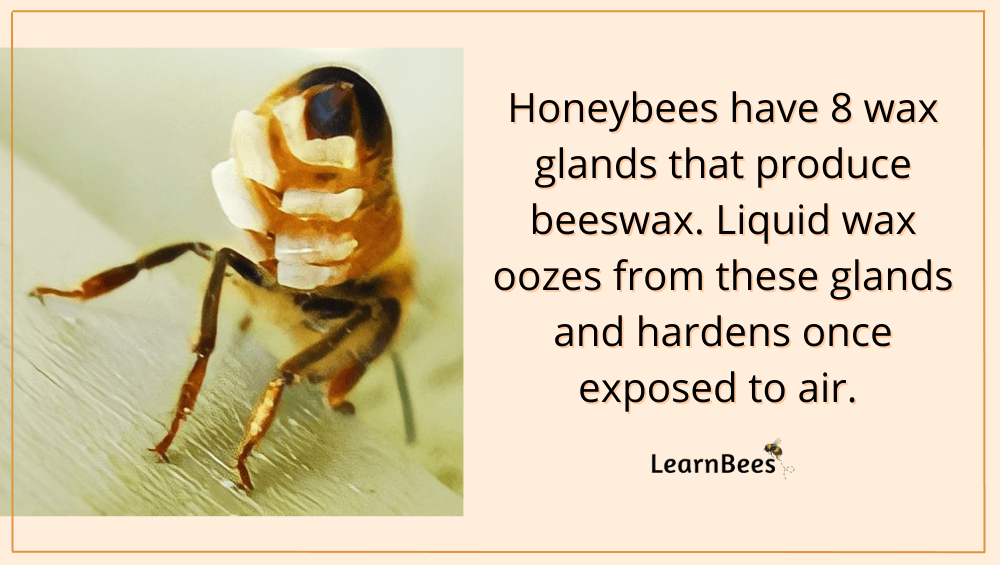
Honeybees make wax from special glands underneath their abdomens. These wax glands secrete liquid wax that solidifies once exposed to air.
At first, the beeswax appears transparent in color but it becomes yellow later.
And the cool part?
Only young female worker bees make wax. Queen bees don’t make it. Male bees don’t make it. Even older worker bees don’t make it.
It’s a unique job given only to young worker honeybees.
Why is that?
Because a worker bees’ wax glands atrophy as they age. As such, producing beeswax is left up to worker bees who are only 12-18 days old. Older worker bees have other job duties, such as foraging for pollen and nectar from flowers.
And here’s the thing:
The wax-making process begins with a young worker bee ingesting large amounts of honey. Next, the bee’s body converts the sugars found in honey into beeswax. The beeswax then oozes out through eight wax glands on the bee’s abdomen.
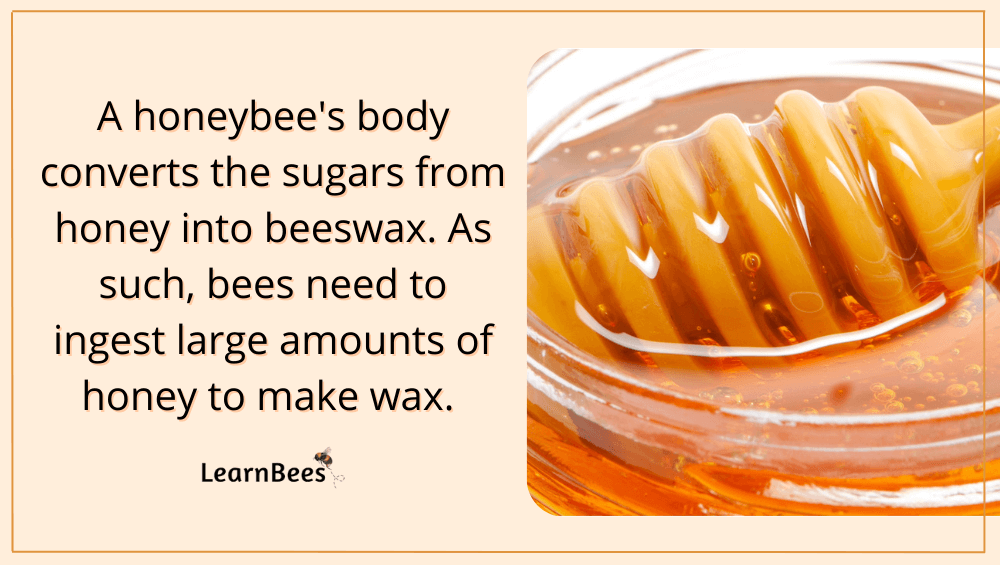
And finally?
The bees chew on the beeswax to get it to the right consistency. Once the wax is pliable, it’s carefully shaped into hexagonal cells that form the entire nest.
Worker bees use their mouths to measure the thickness of the comb. This allows them to add or take away wax as needed.
And get this:
Honeybees need to ingest 6-8 pounds of honey to make a pound of wax.
It’s a lot of work, but it has to be done.
You see, honeybees use wax to build their entire nest. Unlike other types of bees, honeybees don’t nest underground in empty holes. Instead, they build their hives in tree cavities or on branches.
Surprisingly enough:
A single honeybee hive can contain up to 60,000 honeybees. Wax is the foundation of the hive because it has so many uses.
Now that brings us to the next question:
Why Do Bees Make Wax?

Some of the primary uses for beeswax are:
- To store eggs
- For honey storage, so the bees can have food for the winter
- To house bees when they need sleep or rest
And people often ask:
Do bees eat wax?
No, bees don’t eat wax. Instead, they chew it to make it pliable enough to form hexagonal shapes. Sometimes the bees will do ‘remodeling’ work around their hive. This involves taking the wax comb from one section and rebuilding it somewhere else.
So, in a nutshell:
Wax is a crucial part of the honeybee colony.
Not to mention, beeswax has become a staple in skincare products and candles. It’s an incredible substance made up of almost 300 different compounds, including acids, esters, polyesters, fatty alcohols, and more.
But you might be surprised to learn that not all bees produce wax.
Do All Bees Make Wax?
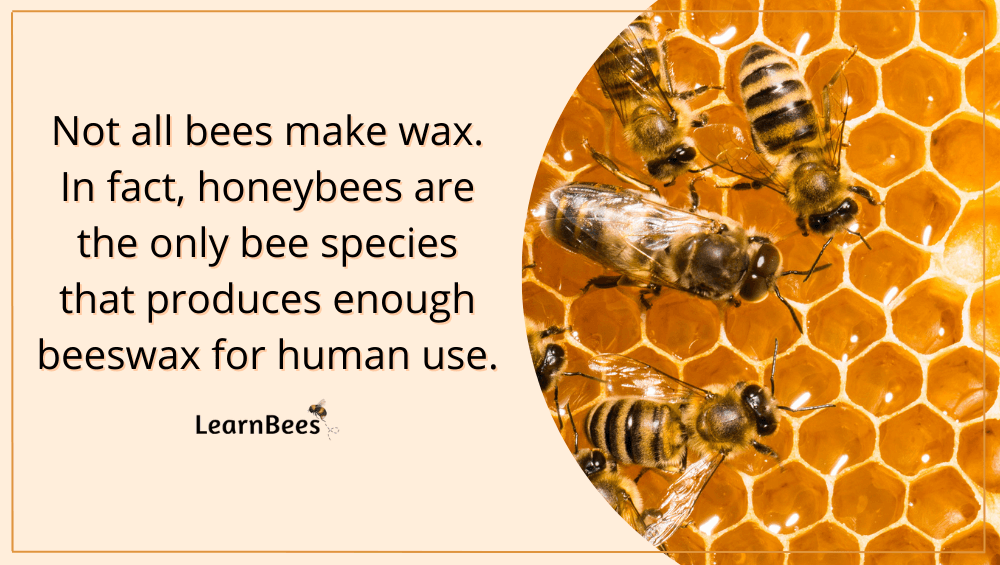
No, not all bees make wax.
For example, carpenter bees don’t produce wax to make comb or cells. They build their nests by drilling into wood like cypress, pine, and redwood.
Other species of bees do make wax, but not on the same scale as honeybees. For instance, some bumblebee species make wax to build small pots that hold honey. Bumblebees also have special wax glands underneath their abdomen.
But let me clarify:
There are over 20,000 species of bees.
As mentioned, most bee species don’t produce as much wax as honeybees. This is because honeybees need wax to store the honey they produce. A large honeybee colony can produce 100 pounds of honey per year.
A lot of honey means a lot of wax.
As a result, honeybees are the only type of bee that makes enough honey and wax for human consumption. So both the honey you buy from the store and the beeswax you see in candles comes from honeybees.
FAQs on “How Do Bees Make Wax?”
- How long does it take for bees to make wax?
- How do bees make hexagons?
- How is wax made from honey?
- How much honey does it take to make wax?
- How do bees make honeycomb?
- Is beeswax vegan?
- Is beeswax edible?
- Do bees make their own wax?
- Where do bees make wax?
- How is beeswax harvested?
How long does it take for bees to make wax?
In a 12-hour period, a healthy worker bee can produce about eight wax scales. The colony needs around 1,000 wax scales to make one gram of beeswax.
Fortunately, honeybees are social bees with large hives. They can produce beeswax and honey on a large scale because they have thousands of helpers. Bees are also hardworking creatures, so they get the job done quickly.
To give you some perspective:
A strong honeybee hive can have a decent amount of wax built after a few short weeks. This is because a single honeybee hive can hold between 50,000 to 60,000 bees.
So even though it takes 1,000 wax scales to produce a single gram of beeswax, it doesn’t take as long as you might think. The bees all work harmoniously together to get the job done. A honeybee colony is like a well-oiled machine.
—> Go back to the FAQs on “How Do Bees Make Wax?”
More to Explore:
How do bees make hexagons?
Honeybees chew up the wax until it’s soft and flexible enough to form into a hexagon shape. They use their mouths to measure the thickness of the beeswax walls. This helps them determine when to add wax or remove wax.
Hexagons are useful shapes for honeybees. They serve many purposes for honeybees, including holding baby bees, storing honey, and giving them a place to rest.
If you think about it, making circular shapes instead of hexagons wouldn’t work because it would leave gaps in the honeycomb.
The hexagon cells make very efficient use of space.
—> Go back to the FAQs on “How Do Bees Make Wax?”
More to Explore:
How is wax made from honey?
The natural sugars in honey get converted into beeswax by the bee’s body.
A little background:
Bees make honey from the nectar of flowers. They store the nectar in an internal organ called a ‘crop.’ Once they bring it back to the hive, they regurgitate the nectar so other colony members can help transform the nectar into honey.
How do they do it?
They fan their wings to increase airflow and evaporate excess water from the nectar. Once the moisture content decreases from 70% to 17-20%, the nectar becomes honey.
Young worker bees make beeswax by ingesting large amounts of honey and pollen. Their body converts the sugars from the honey to make beeswax. The honeybee has eight wax glands underneath its abdomen that ooze liquid wax. Once the wax is exposed to air, it begins to solidify.
—> Go back to the FAQs on “How Do Bees Make Wax?”
More to Explore:
How much honey does it take to make wax?
For every one pound of wax produced, it takes approximately 6-8 pounds of honey.
The bees need to work hard to gather nectar from flowers to produce that much honey. Thankfully, honeybee hives are a big operation. A single hive can have tens of thousands of bees in it.
All the colony members work together to reach their common goals, such as: expanding the hive, making honey, and defending the nest.
—> Go back to the FAQs on “How Do Bees Make Wax?”
More to Explore:
How do bees make honeycomb?
People often ask:
How do bees make beeswax? How do bees make wax comb? How do bees make hives?
Remember that honeycomb is simply a term used to describe where bees store honey. Honeycombs are hexagonal shapes made of beeswax.
Bees make honeycomb by chewing up the wax until it’s soft and flexible enough to form into a hexagon shape. They use their mouths to measure the thickness of the beeswax walls. This helps them determine when to add wax or remove wax.
The hexagon shapes are useful for honeybees because they serve many purposes, including holding baby bees, storing honey, and giving the bees a place to rest.
If you think about it, making circular shapes instead of hexagons wouldn’t work because it would leave gaps in the honeycomb. The hexagon cells make for very efficient use of space.
—> Go back to the FAQs on “How Do Bees Make Wax?”
More to Explore:
- Do Carpenter Bees Pollinate?
- How Long Do Bumble Bees Live?
- Honeybees vs. Bumblebees: How Do They Compare?
Is beeswax vegan?
People regularly ask, “Why is beeswax not vegan?”
Beeswax isn’t considered vegan because it’s a by-product of bees. Bees aren’t technically animals (they’re insects), but they are living creatures that many vegans don’t want to take from.
The beeswax has to be taken from bees to be used. As a result, the bees have to rebuild and replace the wax taken.
That said, beekeepers typically appreciate their bees and don’t overharvest honey or beeswax. This is especially true for small, local beekeepers who don’t run huge commercial operations.
Many beekeepers joined the beekeeping hobby because they love and appreciate honeybees. As a result, they treat their hives well and ethically harvest bee by-products.
In fact, most beekeepers only take honey and beeswax when there’s plenty. This ensures that the bees have enough to survive and thrive.
—> Go back to the FAQs on “How Do Bees Make Wax?”
More to Explore:
Is beeswax edible?
Yes, beeswax is edible. Many people eat honeycomb because it has a sweet, honey flavor with a chewy texture.
It’s not uncommon to see honey jars with honeycomb in their center. You can slice the honeycomb up and eat it straight or on toast.
Remember:
A honeycomb is simply a container for honey. So when you eat honeycomb, you’re eating beeswax and honey. The beeswax by itself has a plain flavor, almost like gum after it’s been chewed. You can swallow the beeswax or spit it out.
—> Go back to the FAQs on “How Do Bees Make Wax?”
More to Explore:
- Ground Bees: Are They a Threat to Your Yard?
- Wasps vs. Honeybees: Are They Different?
- Do Bumble Bees Bite?
Do bees make their own wax?
Yes, bees make their own wax. It’s not something they collect outside of the hive.
That said, not all species of bees make beeswax. For example, carpenter bees don’t make beeswax. Their bodies don’t have the wax-making glands that other bees have. Carpenter bees make their nests inside wood.
In contrast, some types of bees do produce a small amount of wax. For instance, bumblebees use wax to make honey pots that help feed the hive when nectar sources are low.
With that in mind, bumblebees and other bee species don’t produce nearly the amount of wax that honeybees do. Honeybees make a lot of wax because they need containers to store honey and raise baby bees.
This means the beeswax you find in candles strictly comes from honeybees – not bumblebees or any other bee species.
—> Go back to the FAQs on “How Do Bees Make Wax?”
More to Explore:
Where do bees make wax?
The wax gets secreted from special wax glands underneath the bee’s abdomen. They make this wax inside their hive with the help of their colony members. It takes thousands of worker honeybees to build out the nest with beeswax.
Honeybees build their hives mostly in hollow tree cavities. This protects them from the rain and wind while insulating their hive during the cold months.
If you’ve ever seen a honeybee hive, you’ll notice it consists of several dangling sheets of comb. It can be hard to see the hive when it’s tucked away inside a tree cavity. Also, the wax comb is covered with thousands of bees working away on it, so they often block the view.
And lastly, you don’t want to get too close to a honeybee hive because it could alarm the honeybees. This could result in stings.
—> Go back to the FAQs on “How Do Bees Make Wax?”
More to Explore:
How is beeswax harvested?
Beekeepers collect beeswax when they harvest honey. They start by gathering the comb from the hive. Since honeybees cap their honeycomb cells, the beekeeper has to use an uncapping knife to cut off the caps.
This allows the honey to pour freely out of the hexagonal shapes.
Next, they’ll soak the leftover beeswax in warm water to help remove residual honey and pollen. Finally, they’ll melt the beeswax and use a filter to remove the last bits of elements left behind by the bees.
This gives the wax a smoother texture.
